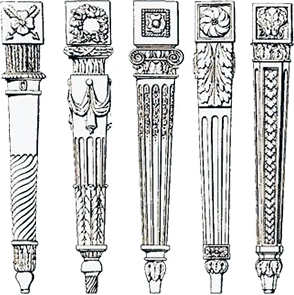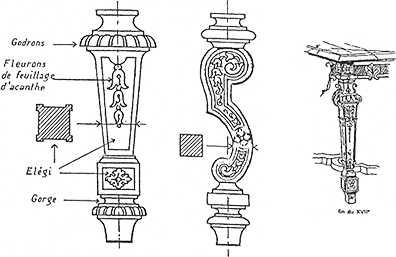Buying Guide
A Guide for the Informed Collector
Antique furniture offers more than utility or ornament. It connects us to craftsmanship, history, and the quiet beauty of objects made with care. Whether you are furnishing a home or acquiring a single piece, buying well requires more than a passing interest. This guide is written to help you recognise quality, distinguish the authentic from the imitative, and approach each purchase with confidence and appreciation.
01
Begin with Affection, Not Ambition
The most compelling reason to buy an antique is that you genuinely love it. Taste should guide the decision – not speculation about potential resale value. A piece that draws your attention, holds your gaze, or feels naturally at home in your space is the right choice. Beauty, when truly recognised, holds its worth.

02
Understand the Price of Quality
New Zealand remains one of the more accessible markets for antique furniture, but true quality rarely comes cheaply. Price reflects age, condition, craftsmanship, provenance, and rarity. A modest-looking commode may command a high price because of its original fittings, period timber, or hand-carved detailing – not simply its outward appearance.
Rather than asking why something is expensive, consider asking why something else is not.
03
Learn Before You Look
Knowledge sharpens the eye. If a particular period or style interests you, spend time learning its forms, materials, and historical context. Understand how furniture was made – the difference between hand-cut and machine-cut joints, the use of timbers native to a region or era, the evolution of hardware and surface treatment.
Being able to identify a Louis XVI chair or a provincial buffet by its construction details is not simply academic. It allows you to distinguish between the exceptional and the ordinary.

04
Recognising Reproductions and Misrepresentations
Reproductions have been made for over a century. Some are finely crafted, others merely decorative. A discerning buyer knows how to read the signs.
Look for tool marks on the reverse of panels. Check for dovetail joints, irregularities in hand-planed surfaces, and timber shrinkage – all of which suggest age. Be wary of plywood backs, Phillips-head screws, or uniform machine finishes. Examine the bottom of drawers and the underside of seats – these areas often reveal more than the façade.
If a seller refers to a piece as “Louis” without specifying which, it likely is not. The distinctions between Louis XIV, XV, and XVI are not interchangeable – and neither are their values.
05
Buy from Those Who Stand Behind Their Pieces
Professional membership offers some assurance of standards. In New Zealand, members of the New Zealand Antique Dealers Association (NZADA) are bound by a code of conduct and are expected to sell with accuracy and integrity.
Internationally, the equivalent is the Confédération Internationale des Négociants en Œuvres d’Art (CINOA) – the International Confederation of Art and Antique Dealers’ Associations. Member organisations are held to strict ethical and professional standards, and many respected dealers worldwide belong to associations under this umbrella.
If purchasing online or abroad, favour dealers who provide clear photographs, thorough descriptions, and are willing to discuss condition and provenance openly. A good dealer welcomes questions and offers clarity, not evasion.
Essentially, you are buying something for life, a life that’ll be richer for it.
Chrystelle Baran, On Living with Antiques


06
Preserve Age - Do Not Polish It Away
Original finishes, aged paint, and time-worn surfaces hold more than aesthetic value. They are records of a piece’s life. Patina – the soft sheen that forms through years of touch and time – cannot be recreated. It should not be stripped, scrubbed, or replaced.
Avoid heavy restorations. Repainting or refinishing can compromise a piece’s integrity and reduce its historical and monetary value. When conservation is necessary, it should be done with restraint and respect.
07
Caring for Antique Wood
Well-maintained furniture can last indefinitely. If the piece is over a hundred years old and made of wood, it should be waxed periodically. Use a traditional beeswax polish and a soft cloth, and avoid commercial sprays that contain silicone or synthetic compounds.
Keep antique furniture away from sources of heat, excessive moisture, or prolonged direct sunlight. Wood continues to respond to its environment, and care should be taken to avoid stress from fluctuating temperatures or humidity.
08
Consider Placement, Access, and Transport
Antiques were not made for lifts, stairwells, or narrow corridors. Before purchasing a large piece, ensure you have measured both the intended space and the access routes to reach it. Consider whether the piece can be disassembled, and if it will require professional transport or handling.
For fragile items, especially mirrors, inlaid surfaces, or pieces with curved legs, it is wise to work with carriers familiar with antiques. Moving them properly is part of preserving their value.
09
An Investment in Sustainability
Unlike mass-produced furniture destined for landfill, antiques have already stood the test of time. They require no new materials, no factory production, and no energy-intensive processing. Choosing antique furniture is not only a matter of taste – it is a quiet act of sustainability.
Buying what already exists is a powerful way to honour the past and protect the future.

To purchase an antique is to enter into quiet conversation with the past. These are not disposable objects – they were made with intention, and they endure because they were valued. Each piece carries signs of its making and traces of its life. When chosen with discernment, an antique becomes not only part of your home, but part of your story.